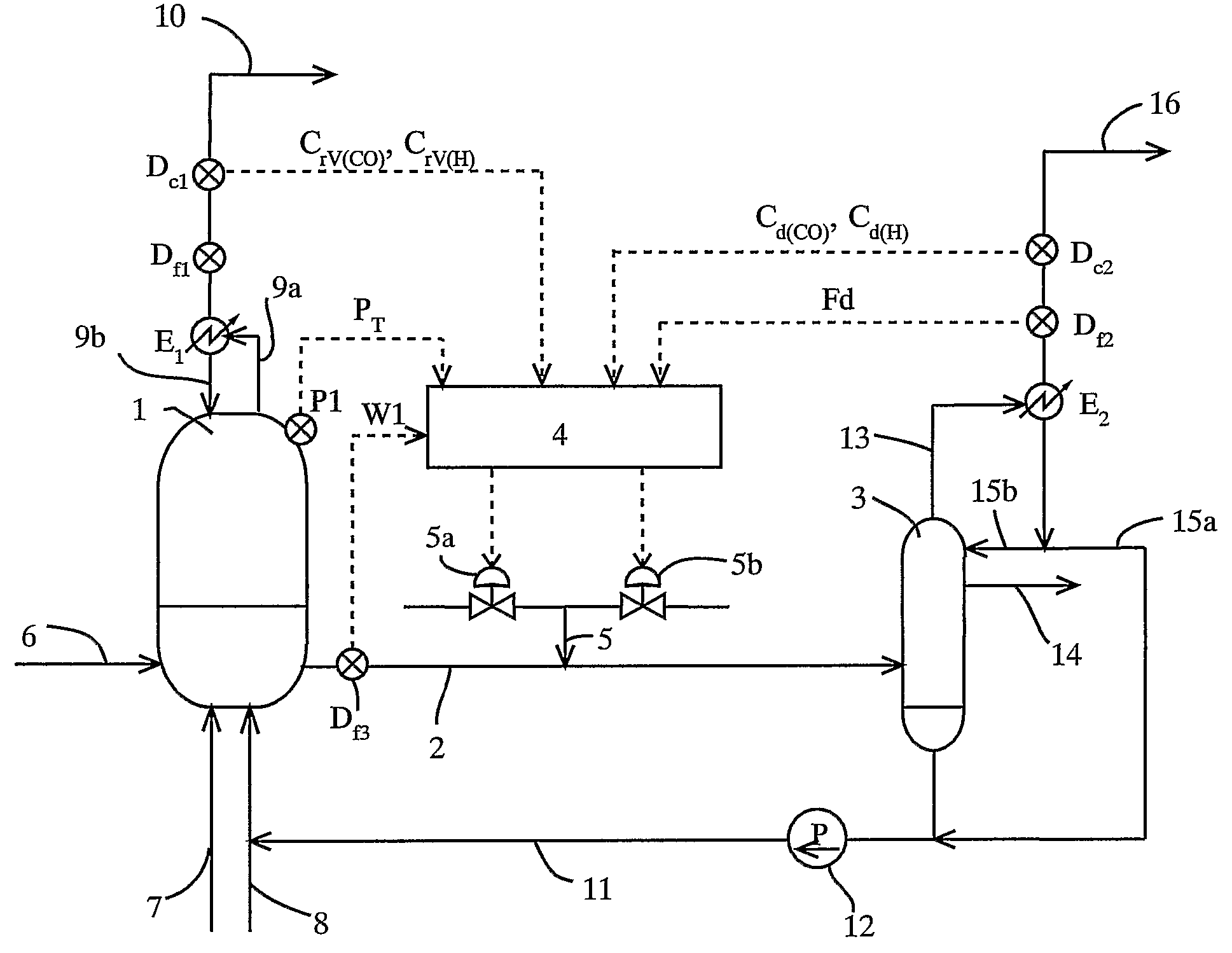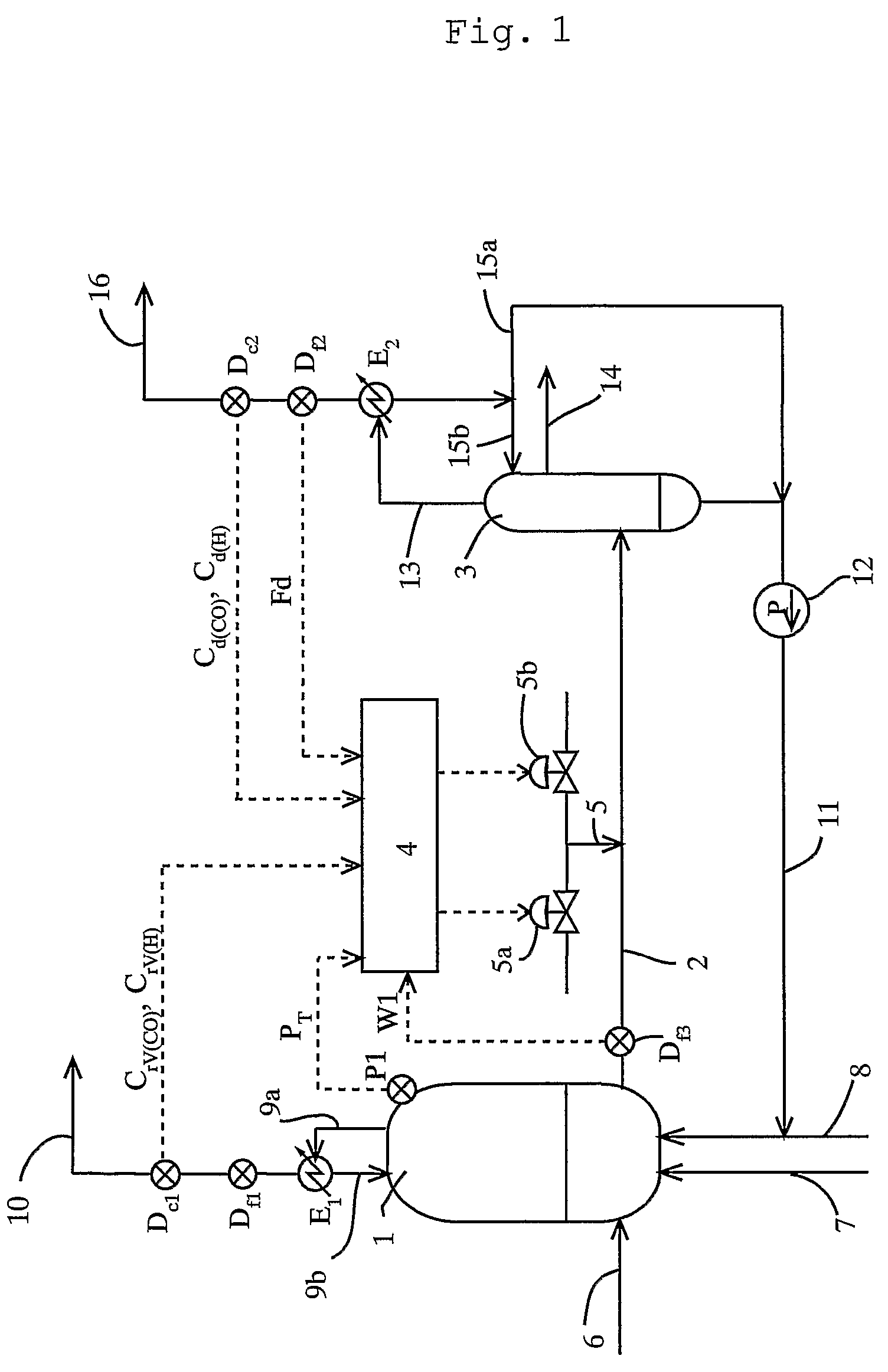Process for producing acetic acid
a technology of acetic acid and process, which is applied in the preparation of carboxylic compounds, carboxylic preparations from carbon monoxide reactions, organic chemistry, etc., can solve the problems of easy reduction of reaction rate, unfavorable catalyst activity or catalyst stability, etc., and achieves enhanced hydrogen partial pressure in reaction, reduced by-product generation, and reduced reaction rate
- Summary
- Abstract
- Description
- Claims
- Application Information
AI Technical Summary
Benefits of technology
Problems solved by technology
Method used
Image
Examples
example 1
[0115]To a reactor, reaction raw materials (methanol and carbon monoxide), a catalyst fluid, and lower-boiling materials (methyl iodide, methyl acetate, and water) were continuously fed, and the reaction was carried out under the following conditions: a reaction pressure of 3.5 MPaG, a carbon monoxide partial pressure of 1.7 MPaA, a hydrogen partial pressure of 0.028 MPaA, and a reaction temperature of 189° C. The reaction fluid was introduced into a flasher at a feed rate of 1.97 kg / h, and the produced acetic acid and other lower-boiling materials were vaporized, and a higher-boiling component containing the catalyst component was circulated to the reactor by pressurizing with a pump.
[0116]The formation rate of acetic acid was 23.1 mol / L / h (mol / (L·h)). Moreover, carbon monoxide and hydrogen discharged from the flasher were 11.4 mmol / h and 6.1 mmol / h, respectively, and the unit partial pressures of carbon monoxide and hydrogen in the reaction fluid per unit weight (kg) of the reacti...
example 2
[0118]To a reactor, reaction raw materials (methanol and carbon monoxide), a catalyst fluid, and lower-boiling materials (methyl iodide, methyl acetate, and water) were continuously fed, and the reaction was carried out under the following conditions: a reaction pressure of 3.5 MPaG, a carbon monoxide partial pressure of 1.9 MPaA, a hydrogen partial pressure of 0.031 MPaA, and a reaction temperature of 186° C. The reaction fluid was introduced into a flasher at a feed rate of 2.00 kg / h, and the produced acetic acid and other lower-boiling materials were vaporized, and a higher-boiling component containing the catalyst component was circulated to the reactor by pressurizing with a pump.
[0119]The formation rate of acetic acid was 23.6 mol / L / h (mmol / (L·h)). Moreover, carbon monoxide and hydrogen discharged from the flasher were 28.8 mmol / h and 8.4 mmol / h respectively, and the unit partial pressures of carbon monoxide and hydrogen in the reaction fluid per unit weight (kg) of the reacti...
example 3
[0121]To a reactor, reaction raw materials (methanol and carbon monoxide), a catalyst fluid, and lower-boiling materials (methyl iodide, methyl acetate, and water) were continuously fed, and the reaction was carried out under the following conditions: a reaction pressure of 3.0 MPaG (gauge pressure), a carbon monoxide partial pressure of 1.3 MPa (absolute pressure), a hydrogen partial pressure 0.029 MPa (absolute pressure), and a reaction temperature of 187° C. The reaction fluid was introduced into a flasher at a feed rate of 2.00 kg / h, and the produced acetic acid and other lower-boiling materials were vaporized, and a higher-boiling component containing the catalyst component was circulated to the reactor by pressurizing with a pump.
[0122]The formation rate of acetic acid was 19.7 mol / L / h (mol / (L·h)). Moreover, carbon monoxide and hydrogen discharged from the flasher were 31.7 mmol / h and 7.4 mmol / h, respectively, and the unit partial pressures of carbon monoxide and hydrogen in t...
PUM
| Property | Measurement | Unit |
|---|---|---|
| partial pressure | aaaaa | aaaaa |
| partial pressure | aaaaa | aaaaa |
| partial pressure | aaaaa | aaaaa |
Abstract
Description
Claims
Application Information
 Login to View More
Login to View More - R&D
- Intellectual Property
- Life Sciences
- Materials
- Tech Scout
- Unparalleled Data Quality
- Higher Quality Content
- 60% Fewer Hallucinations
Browse by: Latest US Patents, China's latest patents, Technical Efficacy Thesaurus, Application Domain, Technology Topic, Popular Technical Reports.
© 2025 PatSnap. All rights reserved.Legal|Privacy policy|Modern Slavery Act Transparency Statement|Sitemap|About US| Contact US: help@patsnap.com



